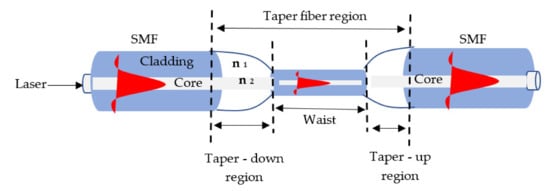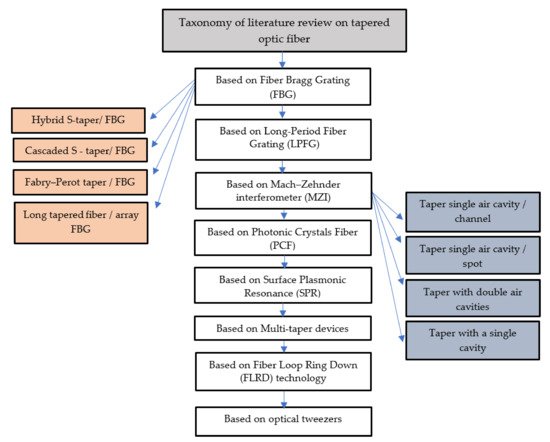1000/1000
Hot
Most Recent

Understanding environmental information is necessary for functions correlated with human activities to improve healthcare quality and reduce ecological risk. Tapered optical fibers reduce some limitations of such devices and can be considerably more responsive to fluorescence and absorption properties changes.


|
Tapered Method |
Challenges |
|---|---|
|
Fiber Bragg grating (FBG) |
• Some spectra of reflection overlapped. • Unstable interference wave. • Complex configuration for grating inscription. • Insufficient sensitivity. |
|
Long-period fiber grating (LPFG) |
• The spectrum is limiting. • Cross-sensitivity problem. • The roughness of the surface. |
|
Mach–Zehnder (MZI) |
• Spectral band-width is limited. • Manufacturing cost. • Sensitivity enhancement is required. |
|
Photonic crystals (PC) |
• The samples given are limited. • The manufacturing of metal layers is a complex procedure. • Integration is expensive. • Mechanical reliability is weak, and mass production is challenging. |
|
Surface plasmon resonance (SPR) |
• The life of the sensitive layer controls the lifetime of the device. • Small sample size. • There is a need for practical application, including different sample collection processes. • The waist area is rather hard. |
|
Multi-taper devices |
• Measured refractive index range is limited. • Limited stability. • The roughness of the surface. |
|
Fiber loop ring-down technology |
• The samples given are limited. • Measuring accuracy depends on the high wavelength resolution of the de-modulation device. |
|
Optical tweezers |
• Obtain an analytical formula for the output light field is difficult. • The trapping of optical tweezers is inadequate due to the limit of laser beam diffraction. • Dramatic disruptions from molecular diffusion. |